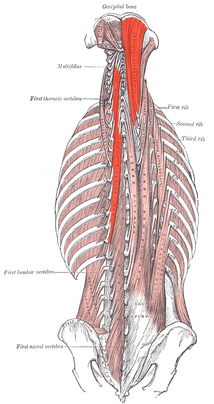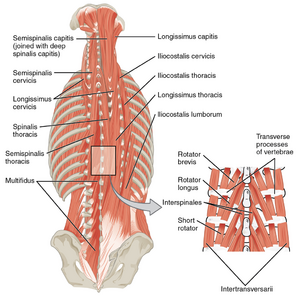Semispinalis: Difference between revisions
No edit summary |
No edit summary |
||
| Line 41: | Line 41: | ||
* [[File:Back Muscles gym.jpeg|thumb|259x259px|Defined muscles]]The semispinalis capitis is the largest muscle in the posterior neck. | * [[File:Back Muscles gym.jpeg|thumb|259x259px|Defined muscles]]The semispinalis capitis is the largest muscle in the posterior neck. | ||
* The semispinalis cervicis and capitis lie deep to the upper trapezius. Muscle pain that emanates from this region is often misdiagnosed as a trapezius injury, when it is a semispinalis problem. | * The semispinalis cervicis and capitis lie deep to the upper trapezius. Muscle pain that emanates from this region is often misdiagnosed as a trapezius injury, when it is a semispinalis problem. | ||
* The greater occipital nerve (innervates the posterior scalp) pierces through the semispinalis capitis (as well as the upper trapezius). An overactive tight semispinalis capitis can compress this nerve causing greater occipital neuralgia<ref>Learn Muscles [https://learnmuscles.com/glossary/semispinalis/ Semispinalis] Available: https://learnmuscles.com/glossary/semispinalis/<nowiki/>(accessed 2.2.2022)</ref>. | * The greater [[Occipital Bone|occipital]] nerve (innervates the posterior scalp) pierces through the semispinalis capitis (as well as the upper trapezius). An overactive tight semispinalis capitis can compress this nerve causing greater occipital neuralgia<ref>Learn Muscles [https://learnmuscles.com/glossary/semispinalis/ Semispinalis] Available: https://learnmuscles.com/glossary/semispinalis/<nowiki/>(accessed 2.2.2022)</ref>. | ||
== References == | == References == | ||
<references /> | <references /> | ||
Revision as of 10:05, 2 February 2022
Original Editor - Lucinda hampton
Top Contributors - Lucinda hampton and Kim Jackson
Introduction[edit | edit source]
The semispinalis muscle belongs to the transversospinalis muscles. The transversospinalis muscle group is a very deep layer of muscles located on either side of the spine.
The semispinalis muscle is:
- The most superficial layer of this muscle group.
- The largest muscle mass in the posterior part of the neck.
- Responsible for maintaining posture and for movement of the head and the vertebral column.[1]
- Has the longest fascicles of transversospinalis group, spanning six segments.[2]
Anatomy[edit | edit source]
The muscles in this group are the semispinalis capitis, semispinalis cervicis, and the semispinalis thoracis.
- Semispinalis capitis muscle lies superficial to the semispinalis cervicis muscle and deep to the splenius capitis and cervicis and trapezius
- Semispinalis cervicis muscle fascicles cover the cervical and thoracic multifidus muscles
- Semispinalis thoracis muscle thin, fleshy fascicles with long tendons at either end; covers the thoracic multifidus muscle
- origin: T6-T10 transverse processes
- insertion: C6-T4 spinous processes
Deep Intrinsic Back Muscles[edit | edit source]
The Semispinalis muscles belong to the intinsic/ deep muscles of the back . These muscles are well-developed, and collectively extend from the sacrum to the base of the skull. They are associated with the movements of the vertebral column, and the control of posture.
The deep muscles of the back are subdivided in 3 groups
- Superficial,
- Intermediate and
- Deep layers. Transversospinales muscle group lies deep to the Erector Spinae. It consists of 3 major subgroups:
- Semispinalis,
- Multifidus
- Rotatores.
Physiotherapy Implications[edit | edit source]
- The semispinalis capitis is the largest muscle in the posterior neck.
- The semispinalis cervicis and capitis lie deep to the upper trapezius. Muscle pain that emanates from this region is often misdiagnosed as a trapezius injury, when it is a semispinalis problem.
- The greater occipital nerve (innervates the posterior scalp) pierces through the semispinalis capitis (as well as the upper trapezius). An overactive tight semispinalis capitis can compress this nerve causing greater occipital neuralgia[3].
References[edit | edit source]
- ↑ Healthline Semispinalis Available: https://www.healthline.com/human-body-maps/semispinalis-muscle#1(accessed 2.2.2022)
- ↑ Radiopedia Transversospinalis muscle group Available: https://radiopaedia.org/articles/transversospinalis-muscle-group?lang=gb(accessed 2.2.2022)
- ↑ Learn Muscles Semispinalis Available: https://learnmuscles.com/glossary/semispinalis/(accessed 2.2.2022)









